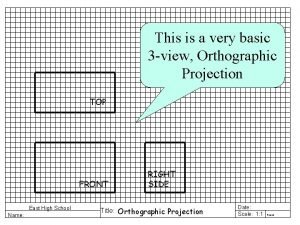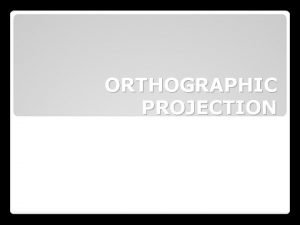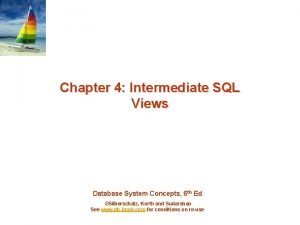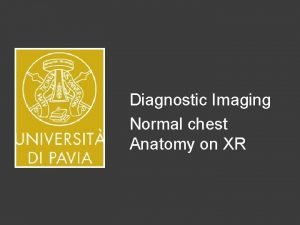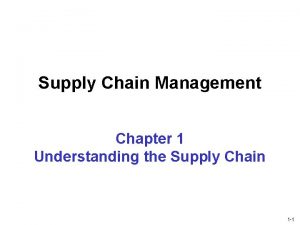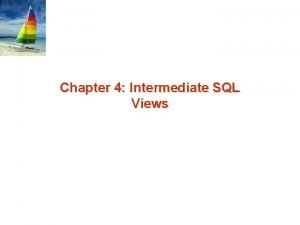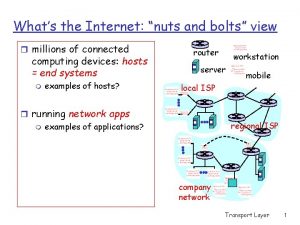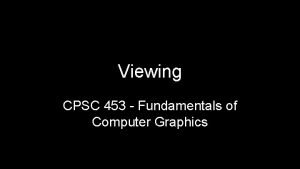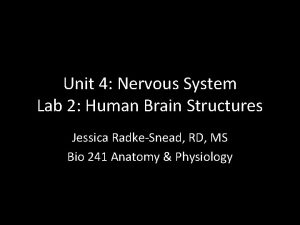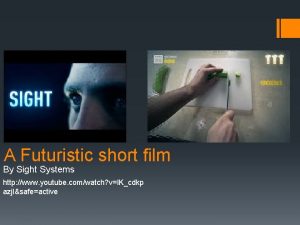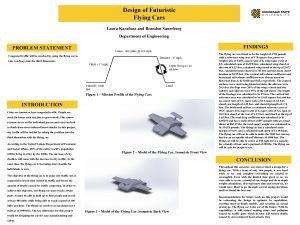Futuristic view of C 4 I systems in







































- Slides: 39


Futuristic view of C 4 I systems in civil and defense -- Requirements and road map

Sequence n Command, Control, Communications, Computer & Intelligence (C 4 I) n Tenets of C 4 I n Network-Centric Warfare n Communication and its Medium n Comparison of Transmission Bands n Role of Satellite Systems for Supporting C 4 I Infrastructure n Advantages & Disadvantages of Ka-band n Regenerative Satellites n Conclusion 3

Command, Control, Communications, Computer & Intelligence (C 4 I) in Military Applications What Is C 4 I? n n n The acronym C 4 I stands for "command, control, communications, computers, and intelligence“. The Strategic Vision for C 4 I is to provide capabilities that enable forces to generate, use, and share that enable forces to information necessary to survive and succeed on every mission. One important capability that C 4 I systems provide commanders is situational awareness—information about the location and status of enemy and friendly forces. 4

Command, Control, Communications, Computer & Intelligence (C 4 I) n n Command Control (C 2) -The exercise of authority and direction by a properly designated commander over assigned and attached forces in the accomplishment of the mission Communications - Communications network is the key enabler of C 4 I that transports information between all tiers of the battlefield Computers - Support C 2 and intelligence by processing information for achieving desired objectives Intelligence (I) - Information and knowledge about an adversary obtained through observation, investigation, analysis, or understanding. 5

Command, Control, Communications, Computer & Intelligence (C 4 I) Command & Control Computers • • • Integration, Processing, Correlation of Info • • Battle Field Management System Air Defense Surveillance Sys Communication • • • Radio Links O/F Networks SATCOM • • AEW Ground Radar EW System UAV Sensors Intelligence Weapons Fighter Aircraft Missiles Ground Troops • • • 6

Command, Control, Communications, Computer & Intelligence (C 4 I) Architecture VHF AOC UHF SOC Link-16 BOC GES LRR C 4 I Secure Network RECON HF GSS PABX Link 11 ADOC GES Remote Workstation Missiles External Services 6

Tenets of C 4 I The tenets of C 4 I are: are _ n n n A robustly networked force improves information sharing. Information sharing and collaboration enhance the quality of information and shared situational awareness. Shared situational awareness enables selfsynchronization. These, in turn, dramatically increase mission effectiveness. The above capabilities are accomplished by a Reliable and Secure Communications Network. 9

Network Centric Warfare as a New Trend in C 4 I Applications n n n An emerging theory of war in the Information Age Using information sharing to gain competitive edge Increased shared situational awareness relying on computation and networked communications technology Enhanced speed of command Networking sensors, decision makers, and shooters to increases synergy for command control, resulting in superior decision-making for an overwhelming war-fighting advantage. 10 10

C 4 I Sensor Shooter Decision Maker Operator Comm System (Radar) Comm System (Combined Operational Picture) (Aircraft) NCW 11

Advantages of NCW Some military advantages that are expected from applying NCW systems to military operations include the following: n n n n To achieve shared awareness, Increased speed of command, High tempo of operations, Greater lethality, Increased survivability, and A high degree of self-synchronization. The key principle of network centric operations is that: providing a superior level of integration among separate systems by allowing every user gets all the needed information in the correct format and in timely manner to achieve Interoperability and superior decision-making. 12 12

Network Centric Warfare – As a Dynamic Autonomous Digital Battlefield Joint Air Support UAV JSTAR RAH LAM/PAM Theater TOC UAV UAV Airborne TOC Field TOC NLOS RECON LOS/BLOS MUGS CDR/C 2 NLOS/BLOS Robotic Sensor NLOS Infantry Fighting Vehicle Robotic Sensor 13

Role and Importance of Communications in C 4 I n n n C 4 I is about networking and cannot survive without effective communication means. Communication provides essential linkages to war system at every level of operation. The importance of communication in C 4 I makes it our primary center of gravity for opponents to exploit our warfare capability Communication - is the heart beat of C 4 I systems 14

Challenges concerning the deployment of C 4 I Systems n Communication challenges: • Interoperability: no seamless and dynamic interoperation between C 4 I nodes. • Protocols Mismatched: no exchange of relevant information due to lack of consistent format. • Different Software: versions and releases between C 4 I nodes are not the same • • • Different Operating Systems Obsolescence in Technology: hardware and software Integration of New technology with legacy systems QOS Requirements Bandwidth limitation due to type of Medium and Service locations 15 15

Comparison between Communication Media Wireline OFC MW Satellite Low Max Limited Moderate in Ka Low in C&Ku Difficult Easier (subject to terrain & distance) (subject to terrain) (subject to distance) Easiest (independent) Limited (LOS) Unlimited (BLOS) Mobility Poor Moderate High Propagation Delay Low Low High Flexibility Poor Moderate High Moderate Very Low High Bandwidth Deployment Geographical Range Susceptibility to ECM 16 High

Advantages of Satellite System to C 4 I n n n Provides high mobility and quick deployment (Tactical operations) Wide geographical coverage (Remote Locations) Installation and running costs are independent of distance (Budgetary) n Independent of terrestrial infrastructure (Flexibility) n Maintenance free medium (Reliability) 17

Disadvantages of Satellite Systems n Limited BW compared to fiber networks (Transponders and Power Limitation) n Propagation delay (Effect on Encryption and Synchronization) n Susceptibility to ECM and Threat Access (Interception, Jamming, Spoofing or Cyber Attack) n Dependence on weather (Fading) (Rain 18

Satellite Transmission Bands Frequency Band Downlink Uplink C 3. 7 – 4. 2 GHz 5. 925 - 6. 425 GHz Ku 11. 7 -12. 2 GHz 14. 0 -14. 5 GHz Ka 17. 7 -21. 2 GHz 27. 5 -31. 0 GHz X-band is not considered due to complexity of equipment for this purpose. 19

Comparison between Satellite Bands Frequency Band Throughput/ VSAT Antenna Size Coverage Propagation Delay Rain Fade C 0. 1– 0. 5 Mbps Large Global 0. 5 sec Low Ku 2 -6 Mbps Small Wide Beam 0. 5 sec High Ka 8 -20 Mbps Smaller Spot Beam Advantages 1. 0 sec (due to Double Hop) Higher Disadvantages Ka-band is the current trend in Satellite Communications due to other bands are becoming saturated 20

Wide Beam Propagation : C & Ku Bands SATCOM Information travels to a site in a Single Hop 21

Ka-band: Multiple Spot Beams SATCOM Beam 3 Beam 4 Beam 1 Beam 2 22

Ka-band: Spot Beams Satellites q Typical Satellite acts as a repeater station in the space. q Spot beam satellites provide fixed data channel to communicate between different beams. q It can be said that communication channels between beams are hard wired. This is called the Bent Pipe Architecture q Therefore all the data received from various users by the satellite is transmitted to the Satellite HUB station and then re-transmitted to the desired destination by the satellite (double Hop architecture) q Steerable beams allows more flexibility with respect to Coverage areas. 23

Bent Pipe Satellites 24

Spot Beam. SATCOM Propagation : Ka-band Transmission A B Information travels from site to site in a Double Hop Site A Hub Station Site B 25

Advantages of Ka-band over other Bands § Greater throughput § More potential: currently widely used as lower bands such as C/ Ku become more congested § Spot Beam – Ø Enables Frequency re-use as explained in upcoming slide Ø Less susceptible to interception and jamming § High Mobility - smaller dish size Some Disadvantages of Ka-band § § Propagation Delay – Double hop due to Bent pipe architecture Rain Fading - Due to absorption of high frequency electromagnetic waves by water droplets 26

Ka-band: Frequency Re-use on Spot Beams n n Frequency is re-used in non-adjoining spot beams to avoid interference Frequency re-use is achieved by alternating the frequency sub-band and/or polarization used by each spot beam across coverage area Frequency re-use increases the overall satellite capacity Greatest commercial advantage 27

Overcoming Propagation Delay in Current Bent Pipe Architectures SATCOM From Remote Site to AOC in C 4 I Platforms 2 1 Site B Gateway Station 3 Fiber Optical Cable Site A Remote Site AOC (C 2 Center) 28

29

Attenuation caused by Rain Fade Ka-band is great for MENA region as it receives less Rainfall leading to lesser attenuation 30

Threats to Information Security Major Threats • Jamming • Interception • Spoofing Counter Measures • Transmission Security (Transec) • Communication Security (Comsec) 31

Overcoming threats to Information Security OSI Model Physical Security COMSEC Network Layer Data Link Layer Physical Layer Content protection Radio interface Authentication / confidentiality NETSEC Protection of signaling Transmitter authentication Data Link Layer Physical Layer TRANSEC Protection of waveform Transmitter finding Receiver jamming Physical Layer 32

Overcoming threats to Information Security TRANSEC n Protection of waveform from interception and direction to avoid receiver jamming, transmitter finding and access to radio signal. n Spread spectrum n Implemented at Physical Layer 33

Overcoming threats to Information Security COMSEC n n n Protection of information content by safeguarding authentication, confidentiality, integrity of signal and user data Implemented at Physical, Data Link and Network layers May be achieved through secure VPN or Cyber Protection Systems 34

Regenerative Satellite System Space Segment Rx Demod Packet Switch Mod Tx Uplink Site A Downlink Site B Ground Segments 35

Regenerative Satellite Ø Uplink carrier is § Demodulated to data packets, § Rearranged on the basis of routing information § Re-modulated onto downlink carrier § Re-transmitted to the desired spot beam. Ø Data from a particular beam can be transmitted to any beam by using satellite onboard switching Ø Improved (S/N) as data is regenerated which removes noise leading to higher throughput Ø Enabling on board satellite switching avoids Double Hop propagation delay for site to site communications Ø Very expensive satellite Ø Regenerative satellite is the latest trend in SATCOM technology with onboard switching and routing, enabling communications directly between terminals in a single hop without requiring a central hub. 36

Bent Pipe versus Regenerative Satellites 37

Conclusion n n Communication is the fundamental component of C 4 I which is the key enabler of NCW Optical fiber provides maximum bandwidth connectivity in (Tbps) but has lesser flexibility for remote deployment Satellite is the best suited to provide interconnectivity, survivability and interoperability for remote and mobile setups due to easy deployment however it has limited bandwidth capacity and greater propagation delay. Ka-band satellites provide greater throughput than C or Ku band Satellites Most Ka-band satellites are base on Bent Pipe architecture whereby a double hop is needed to communicate between remote sites 38

Conclusion cont’ n n n The double hop in Ka-band (bent pipe) satellites may be avoided by providing fiber connectivity from Satellite Gateway to fixed sites (specially AOC) where possible. Regenerative on Board Processing Ka satellites provides routing and switching on the satellite which enhances throughputs and avoids double hop propagation. Regenerative Ka-band communication satellites are the new trend on SATCOM technology and will be the best suited for military use in C 4 I applications. SATCOM is an essential requirements for C 4 I by: v Deployed tactical forces, v Providing ideal continuity for operational services. Standard Gigabit Ethernet (GE) interface as an open system architecture approach allows easy interconnectivity and interoperability to connect all C 4 I nodes. 39

Any Questions? Thank you 40
 Futuristic nursing definition
Futuristic nursing definition Orthographic view drawn directly above the front view
Orthographic view drawn directly above the front view Half section view example
Half section view example Removed view
Removed view Partial section view
Partial section view Worms eye camera angle
Worms eye camera angle Elevation in orthographic projection
Elevation in orthographic projection Orthographic drawing to isometric
Orthographic drawing to isometric For the view create view instructor_info as
For the view create view instructor_info as Simple view and complex view
Simple view and complex view Simple view and complex view
Simple view and complex view Simple view and complex view
Simple view and complex view What is a partial view
What is a partial view X ray indication
X ray indication Scm cycle view
Scm cycle view Operating system components
Operating system components Objective of ethics
Objective of ethics Multi view drawings
Multi view drawings Front view top view
Front view top view Isometric
Isometric For the view create view instructor_info as
For the view create view instructor_info as A system view of project management
A system view of project management Decision support systems and intelligent systems
Decision support systems and intelligent systems Dicapine
Dicapine Embedded systems vs cyber physical systems
Embedded systems vs cyber physical systems Elegant systems
Elegant systems X ray mastoid towne's view position
X ray mastoid towne's view position Clue words for third person point of view
Clue words for third person point of view Nuts and bolts of internet
Nuts and bolts of internet Strategy as a perspective
Strategy as a perspective West virginia view
West virginia view Pvhs infinite campus
Pvhs infinite campus Sharp lab
Sharp lab Vista view
Vista view Normalized device coordinates
Normalized device coordinates Paranasal sinus at birth
Paranasal sinus at birth Operational view specification in iot
Operational view specification in iot Battle royal invisible man
Battle royal invisible man Folia brain
Folia brain Data independence in dbms
Data independence in dbms

